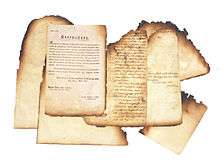July Revolt of 1927
The July Revolt of 1927 (also known as the Vienna Palace of Justice fire, German: Wiener Justizpalastbrand) was a major riot starting on 15 July 1927 in the Austrian capital Vienna. It culminated with police forces firing into the outraged crowd, killing 89 protesters,[1] while five policemen died. More than 600 protestors and around 600 policemen were injured.
Vienna Palace of Justice in the 1880s | |
| Date | 15 July 1927 |
|---|---|
| Location | Vienna, Austria |
| Participants | Austrian Social Democrats |
| Outcome |
|
Events
The clash was the result of conflict between the Social Democratic Party of Austria and a right-wing alliance including wealthy industrialists and the Catholic Church. Many paramilitary forces had been formed in Austria during the early 1920s, among them the Nationalist Frontkämpfervereinigung Deutsch-Österreichs under Col. Hermann Hiltl and the Social Democratic Republikanischer Schutzbund. A clash between those groups during a gathering in Schattendorf, Burgenland on 30 January 1927 resulted in the death of a World War I veteran and an eight-year-old boy. Three Frontkämpfer were indicted in a Vienna court in July for shooting them in an ambush. Defended by lawyer Walter Riehl, and pleading self-defence, they were acquitted in a jury trial.
This "Schattendorf Verdict" led to a general strike which had the aim of bringing down the government headed by Christian Social Party chancellor Ignaz Seipel. Massive protests began on the morning of 15 July, when a furious crowd tried to storm the main building of the Vienna University on the Ringstrasse. The protesters attacked and damaged a nearby police station and a newspaper building, before proceeding to the Austrian Parliament Building. Forced back by police, they arrived in the square in front of the Palace of Justice. At about noon, protesters entered the building by smashing the windows; they then demolished the furnishings and began setting fire to files. Soon the building was ablaze; the fire spread out quickly, as the Vienna fire brigade was attacked by several demonstrators who cut the hoses and so prevented its being brought under control until the early morning.
The former (and later) Austrian chancellor Johann Schober, then Vienna chief of police, suppressed the protests with force. He urged the Social Democratic mayor Karl Seitz to call for the Austrian Armed Forces, which Seitz rejected, as did the Christian Social Party defence minister Carl Vaugoin. In turn, Schober supplied the police troops with army rifles and publicly announced that the premises would be cleared by force if the fire brigades could not work unhindered, after Seitz and Schutzbund councillor Theodor Körner tried to persuade the crowd to surrender in vain. The police opened fire, which left 5 police officers and 89 demonstrators dead.
Remembrance

A memorial to the victims was erected in the Vienna Zentralfriedhof; a plaque at the Palace of Justice was unveiled by President Heinz Fischer in 2007. Several artifacts such as singed court papers and Schutzbund and Frontkämpfer uniforms are on display at the Heeresgeschichtliches Museum.
See also
References
- Brook-Shepherd, Gordon (December 1996). The Austrians : a thousand-year odyssey. HarperCollins. p. 260. ISBN 0-00-638255-X.
- G.R.E. Gedye, Fallen Bastions (London, 1939)
- F. Carsten, Fascism in Austria (London, 1977)